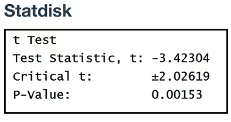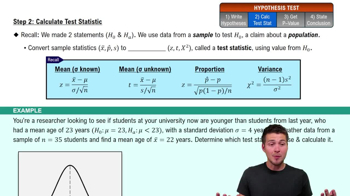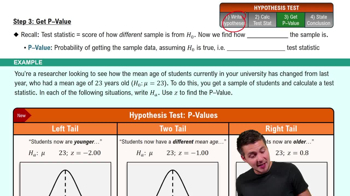One-Way ANOVA In general, what is one-way analysis of variance used for?
Table of contents
- 1. Intro to Stats and Collecting Data1h 14m
- 2. Describing Data with Tables and Graphs1h 55m
- 3. Describing Data Numerically2h 5m
- 4. Probability2h 16m
- 5. Binomial Distribution & Discrete Random Variables3h 6m
- 6. Normal Distribution and Continuous Random Variables2h 11m
- 7. Sampling Distributions & Confidence Intervals: Mean3h 23m
- Sampling Distribution of the Sample Mean and Central Limit Theorem19m
- Distribution of Sample Mean - Excel23m
- Introduction to Confidence Intervals15m
- Confidence Intervals for Population Mean1h 18m
- Determining the Minimum Sample Size Required12m
- Finding Probabilities and T Critical Values - Excel28m
- Confidence Intervals for Population Means - Excel25m
- 8. Sampling Distributions & Confidence Intervals: Proportion1h 12m
- 9. Hypothesis Testing for One Sample3h 29m
- 10. Hypothesis Testing for Two Samples4h 50m
- Two Proportions1h 13m
- Two Proportions Hypothesis Test - Excel28m
- Two Means - Unknown, Unequal Variance1h 3m
- Two Means - Unknown Variances Hypothesis Test - Excel12m
- Two Means - Unknown, Equal Variance15m
- Two Means - Unknown, Equal Variances Hypothesis Test - Excel9m
- Two Means - Known Variance12m
- Two Means - Sigma Known Hypothesis Test - Excel21m
- Two Means - Matched Pairs (Dependent Samples)42m
- Matched Pairs Hypothesis Test - Excel12m
- 11. Correlation1h 6m
- 12. Regression1h 50m
- 13. Chi-Square Tests & Goodness of Fit1h 57m
- 14. ANOVA1h 57m
9. Hypothesis Testing for One Sample
Steps in Hypothesis Testing
Problem 9
Textbook Question
Technology
In Exercises 9–12, test the given claim by using the display provided from technology. Use a 0.05 significance level. Identify the null and alternative hypotheses, test statistic, P-value (or range of P-values), or critical value(s), and state the final conclusion that addresses the original claim.
Peanut Butter Cups Data Set 38 “Candies” includes weights of Reese’s peanut butter cups. The accompanying Statdisk display results from using all 38 weights to test the claim that the sample is from a population with a mean equal to 8.953 g.

 Verified step by step guidance
Verified step by step guidance1
Step 1: Identify the null and alternative hypotheses. The null hypothesis (H₀) states that the population mean is equal to 8.953 g (H₀: μ = 8.953). The alternative hypothesis (H₁) states that the population mean is not equal to 8.953 g (H₁: μ ≠ 8.953). This is a two-tailed test.
Step 2: Determine the test statistic. From the Statdisk display, the test statistic is t = -3.42304. This value measures how far the sample mean deviates from the hypothesized population mean in terms of standard errors.
Step 3: Identify the critical t-value. The critical t-value for a two-tailed test at a significance level of 0.05 is ±2.02619, as shown in the Statdisk display. This value defines the rejection regions for the null hypothesis.
Step 4: Compare the test statistic to the critical t-value. Since the test statistic t = -3.42304 falls outside the range defined by the critical t-values (±2.02619), it lies in the rejection region.
Step 5: Evaluate the P-value. The P-value is 0.00153, which is less than the significance level of 0.05. This indicates strong evidence against the null hypothesis. Based on the test statistic and P-value, the null hypothesis is rejected, and the conclusion is that the sample is not from a population with a mean equal to 8.953 g.
 Verified video answer for a similar problem:
Verified video answer for a similar problem:This video solution was recommended by our tutors as helpful for the problem above
Video duration:
5mPlay a video:
Was this helpful?
Key Concepts
Here are the essential concepts you must grasp in order to answer the question correctly.
Null and Alternative Hypotheses
In hypothesis testing, the null hypothesis (H0) represents a statement of no effect or no difference, while the alternative hypothesis (H1) suggests that there is an effect or a difference. For this question, the null hypothesis would state that the mean weight of the peanut butter cups is equal to 8.953 g, while the alternative hypothesis would claim that it is not equal to this value.
Recommended video:
Guided course

Step 1: Write Hypotheses
Test Statistic
The test statistic is a standardized value that is calculated from sample data during a hypothesis test. It measures how far the sample mean is from the null hypothesis mean, in terms of standard errors. In this case, the test statistic is -3.42304, indicating that the sample mean is significantly lower than the hypothesized mean of 8.953 g.
Recommended video:
Guided course

Step 2: Calculate Test Statistic
P-Value
The P-value is the probability of obtaining a test statistic at least as extreme as the one observed, assuming the null hypothesis is true. A low P-value (typically less than the significance level, such as 0.05) indicates strong evidence against the null hypothesis. Here, the P-value of 0.00153 suggests that there is strong evidence to reject the null hypothesis, supporting the claim that the mean weight is not equal to 8.953 g.
Recommended video:
Guided course

Step 3: Get P-Value

 6:21m
6:21mWatch next
Master Step 1: Write Hypotheses with a bite sized video explanation from Patrick
Start learningRelated Videos
Related Practice
Textbook Question
